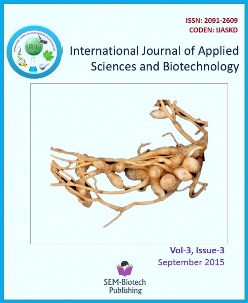Establishment of Enzyme Inhibitory Activities of Lovastatin, Isolated From Pleurotus ostreatus
DOI:
https://doi.org/10.3126/ijasbt.v3i3.12932Keywords:
Pleurotus ostreatus, Lovastatin, DPPH assay, Amylase Assay, Acid Phosphatase Assay, Membrane Stability assayAbstract
Enzyme inhibition is significant biological process to characterize the enzyme reaction, extraction of catalysis parameters in bio-industry and bioengineering. The enzyme inhibitors are low molecular weight chemical compounds. Inhibitor can modify one amino acid, or several side chain(s) required in enzyme catalytic activity. To protect enzyme catalytic site from any change, ligand binds with critical side chain in enzyme. Safely, chemical modification can be done to test inhibitor for any drug value. In the present day world they are known for culinary values due to their high-quality proteins, vitamins, fibers and many medicinal properties and accordingly they are called nutraceuticals. Overproduction of ROS can damage cellular biomolecules like nucleic acids, proteins, lipids, carbohydrates, proteins and enzymes resulting in several diseases. The chemical nature of the bioactive compounds present in this mushroom includes: polysaccharides, lipopolysaccharides, proteins, peptides, glycoproteins, lectins, lipids and their derivatives. We report the presence of Statins in fruiting bodies and fermentation processes from Pleurotus ostreatus. Lovastatin extracted from the Pleurotus ostreatus showed Anti-oxidant Activity when compared with Standard Quercetin, IC50 values of 3.5?g/ml and 7.5 ?g/ml respectively, amylase Assay the percentage inhibitions of 35% and 70 % with 1 and 3 mg/ml respectively. In Membrane Stability assay, the percentage inhibitions of 47.06% and 50%. Acid Phosphatase Assay: percentage inhibitions of 82.78% and 76.11% with 2mg/ml and 4mg/ml respectively. Pleurotus possess a good antioxidant and enzyme inhibitions for Alpha Amylase, Acid Phosphatase and membrane stability studies, hence as health promoter and environmental restorer is gaining more importance.
Int J Appl Sci Biotechnol, Vol 3(3): 408-416




